Despite the fact that energy-saving light bulbs are gradually replaced by LEDs, they still hold the leading position in terms of the number of sales. According to analysts, this situation will last from two to five years, so it makes sense to consider the design of these lighting devices, the principle of operation, as well as other aspects related to their functioning.

What are energy-saving light sources?
In fact, they are fluorescent lamps, they received the name energy-saving in the course of an advertising company, in which the emphasis was on this particular feature of the lighting device. As a result, at the household level, the term has become firmly entrenched for compact fluorescent sources manufactured under the E27 and E14 socles, since they could replace incandescent lamps without problems.
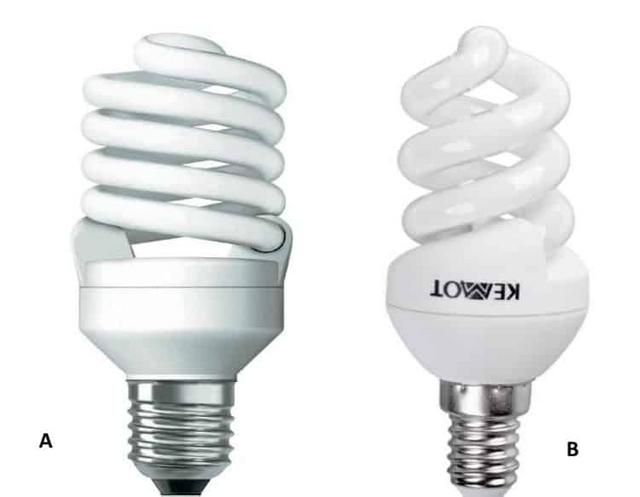
Note that, based on the characteristics of LED light sources, they have more rights to the term "energy-saving", but since they appeared on mass sale for a few years later, this name did not follow them. On the other hand, there is no confusion, when we ask for an energy-saving lamp, you can rest assured that the seller will offer a choice of fluorescent sources.
Types of energy saving lamps
First of all, to avoid confusion, let's define the term "energy-saving". So it is correct to call sources consuming much less electricity than incandescent lamps with an equal in intensity light flux. At the same time, energy-saving light sources can be used instead of LN without making any changes in the design of the lighting fixture. That is, these lamps can be screwed into standard cartridges E27 and E14.
Two types of lamps are suitable for the above definition:
- luminescent;
- LED light.
Each of these types, in turn, is divided into ordinary lamps with a constant light flux and adjustable, using a special device (dimmira). These devices work only with the type of lamps for which they are intended, that is, you can not control the LL light flux by means of a dimmer for LED sources, and vice versa.
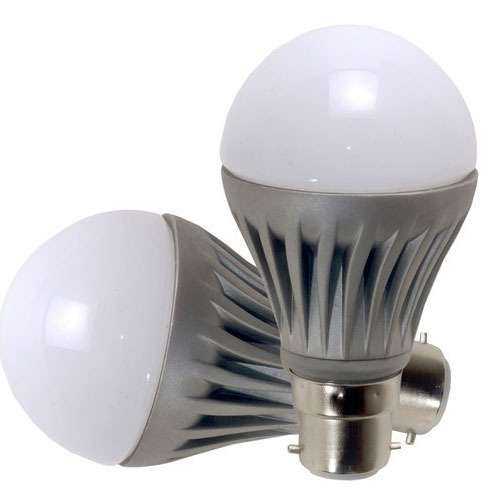
In addition, there is a classification according to the spectrum of the light flux, it is more widely known by the term "white light temperature". The most common are three options:
- Warm, has a soft yellowish tint, is close in the spectrum to LN. It is marked as 2700K, 3000K.
- Natural, the spectrum of such sources is closest to solar illumination. The marking is 4200K.
- Cold, the sources have bright white light (6000K), at higher temperatures a slight blue shade (6400K) appears.
The first option is great for bedrooms and recreation areas, the second is for children's and ordinary rooms, including living rooms, the latter is usually used for lighting workplaces and offices.
Having dealt with types, let's move on to the principle of work. The description of LED sources can be found on our website, so the main attention we paid to LL.
Design features
Virtually all light sources of this category have the same design. It includes a fluorescent lamp bulb, electronic ballast, necessary for start-up and operation and housing. If you are interested in how the ballast block is organized, its typical scheme can be found on our website.
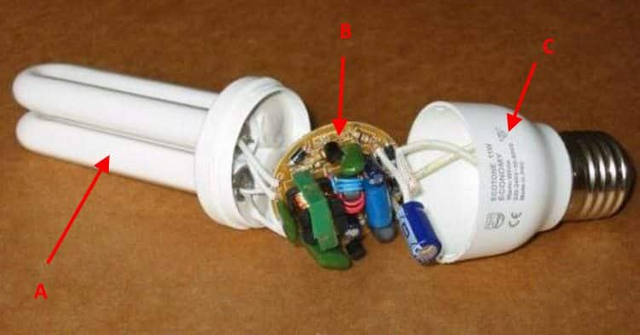
Notation:
A - the bulb of the lighting device., B - electronic ballast., C - housing with fixed base.
Principle of operation
To explain how this lighting device works, it is necessary to show the construction of its main element - a gas-discharge lamp.
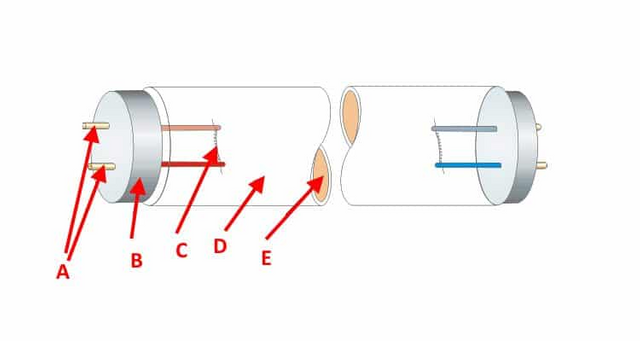
Notation:
A - Contacts of the cathode.,B - Cap of flasks, made of insulating material.,C - Tungsten spiral.,D - Sealed tube of glass;,E - Phosphor coating of the inner surface of the tube.
The algorithm is as follows:
- The voltage is applied to tungsten spirals, they heat the inert gas, which contributes to the formation of mercury vapor.
- A high voltage pulse with different potentials is fed to the cathodes, resulting in the formation of an ionized flow between them.
- Electrons, colliding with mercury atoms, form ultraviolet.
- This radiation affects a special coating of the glass tube, which causes its glow in the visible spectrum.
An electronic ballast in the compact fluorescent lighting housing controls the above process.
Pros, cons, and some aspects of energy-saving sources
We have specially united in one section all the features of fluorescent lighting devices, as some of them, to put it mildly, are rather controversial and require explanations. Let's start with the main feature, which gave the name of this category.
How economical is energy saving?
Despite the advertising, the actual energy savings, compared to LN, for energy-saving sources does not exceed fivefold. And this is only for branded products of high quality. On the other hand, the cost of such devices is also several times higher.
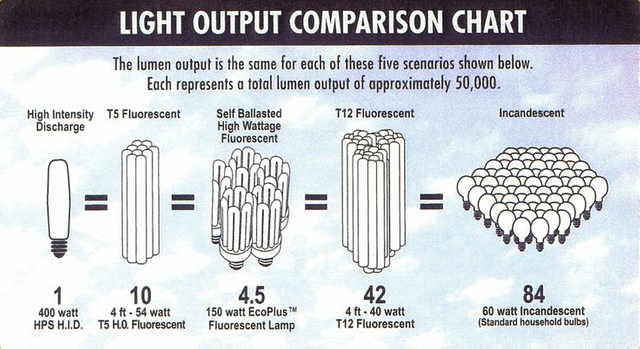
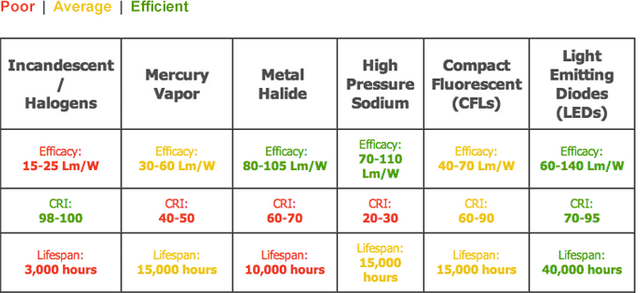
Actually, the purchase will justify itself during operation from six months to a year (depending on the manufacturer and capacity). But it is necessary to take into account the destructive factors that reduce the service life of these devices, such as:
Voltage surges. Given the limited size of the electronic balance, it is problematic to install a voltage regulator, which provides reliable protection against interference and shocks. As a result, the resource of the electronic unit is significantly reduced, so it is not uncommon for lighting devices to fail after a few months of operation. You can fix the situation by setting the voltage regulator at the input to the apartment.
Frequent on and off. Any gas-discharge light source is critical to frequent transient processes.
- Manufacturers indicate a service life of around 9-10 thousand hours, provided that switching on and off will be done once a day. As you know, in reality this happens more often, but even under these conditions, the resource will not be less than 3-3.5 thousand hours, which in any case is greater than that of conventional LN.
- Burn and remission. It should be borne in mind that in order to achieve maximum luminescence, LL requires 80 to 250 hours of operation. This period is called "burning". After reaching the peak, a gradual remission process begins, which is reflected in a decrease in the level of the light flux. For lighting devices of this type, after a year of operation, this figure may be reduced by 30%. Therefore, the manufacturers' declared indicators of comparable capacity 1x5, to put it mildly, are somewhat optimistic. In practice, this value is lower, for brand products 1x4 and Chinese products - 1x3.
About the quality of the light flux
The figure below shows the spectra of various artificial light sources and sunlight. As an energy-saving device, a two-lane LL is shown. Apparently, its spectrum is much poorer, compared with other sources.
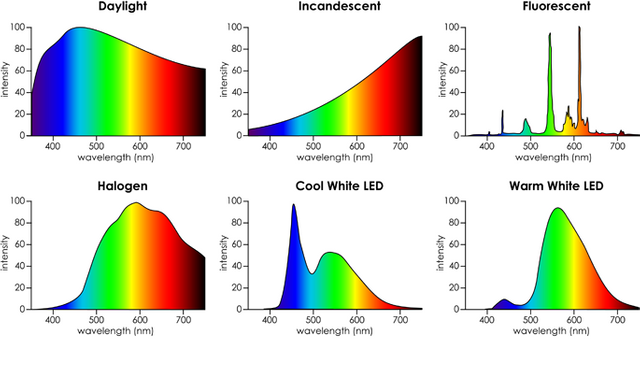
At present, such lamps are practically not produced. Modern LL, as a rule, are produced with three to five band phosphor, which positively affects the quality of the light flux, bringing its spectrum closer to solar illumination. Naturally, sources with a multi-band phosphor are somewhat more expensive, but thanks to modern technologies this difference has become insignificant.
Stroboscopic effect
In compact LL, an electronic ballast is used, which virtually eliminates flickering. To be precise, it is present, but occurs at a high frequency, from 20 kHz or more, the human eye does not perceive such a pulsation. As a result, a monotonous light flux effect is created. It should be noted that, at temperatures below -10 ° C, a lighting device with an LL may experience start-up problems, which in some cases may appear as a stroboscopic effect.
Resistant to low temperatures and moisture
Typical LL work without problems at an ambient temperature of more than -10 ° C. When the lower limit is lower, startup problems start, the lamp can flicker long before it flares up or does not turn on at all. Note that sources with a lower temperature threshold (-20 ° C) are produced. Below this threshold, LL does not work, in contrast to sources with a filament. This, perhaps, is the only advantage of these devices.
As for moisture, it is "afraid" of any electrical appliance, and LL in this case is no exception. The weakest link is the socle, for it there is no effective protection. But this can be said about any lighting source.
Inertia
Sometimes you can hear the opinion that the LL is inherent some inertia at the start, that is, the source flares up within a few seconds. This feature is inherent in devices with a realized warm start process, which allows to increase the resource by 20-25%. In most inexpensive products of Chinese manufacturers, this function is not implemented. As a result, LL is switched on almost instantly (cold start). This dubious pleasure negatively affects the service life. That is, in this case, the inertia is a positive quality.
You can not control the lighting level
It really is, but in part. It is really impossible to operate an energy-saving device to change the lighting level with a conventional dimmer. Changing the voltage level can only disable the light source. To realize this possibility, special equipment is necessary, but in addition, electronic ballast of the source should provide such an opportunity. That is, LL are necessary, in the control blocks of which there are additional leads (control electrodes).
Note that this solution is much more expensive than for LN. The lamp with control electrodes costs about $ 10- $ 16, and the controller is from $ 35 and above.
Necessity of recycling
Since LL contains mercury, throw out a lamp, the exhausted resource is unacceptable, it must be taken to special disposal points, which causes some inconvenience.
What if the light bulb crashed?
Despite the relatively small amount of mercury in LL, as a rule, not more than 6 mg, this is enough to ensure that the vapor content of this exceeds the permissible norm by 200-250 times, which in itself is already a danger. In such situations it is required to immediately demercurize the premises, you can do it yourself. Specialists recommend acting according to the following algorithm:
- Take people out of the room, then open all the windows.
- Wear gauze bandage on your face (you can use a handkerchief for lack of it), and rubber gloves on your hands.
- Carefully pick up fragments of LL and phosphor, then place them in any hermetically sealed non-metallic container (in extreme cases, you can use a dense plastic bag). Remains of the phosphor can not be collected by a vacuum cleaner, for the following reasons:
- heat from the device will accelerate the process of evaporation of mercury;
- vacuum cleaner can not be safely used in the future, it will need to be disposed of.
- Removing the leftovers of LL it is necessary to make a wet cleaning in the room, adding to the water any of the substances that promote demercurization, such as chlorine, baking soda, potassium permanganate (manganese), and also a solution of iodine.
- After the wet cleaning is complete, leave the room to be ventilated for as long as possible.
Wet cleaning and airing the room is recommended to be repeated for several days.
Remnants of LL are subject to disposal, it is strictly prohibited to throw them out with ordinary refuse.
How to choose energy saving light bulbs?
- When choosing in the first place, you need to determine the type, preferably, certainly, LED sources, but they are several times more expensive than luminescent ones.
- Next, you need to make sure that the base of the lamp fits the lighting fixture. Here it is rather problematic to make a mistake, there are only two options, the standard socle (E27) and the minion (E14). If an error occurred and minions were purchased, then you can insert such lamps into a standard cartridge using a special adapter. There are also reverse adapters, but in this case a problem may arise because of insufficient space in the plafond.
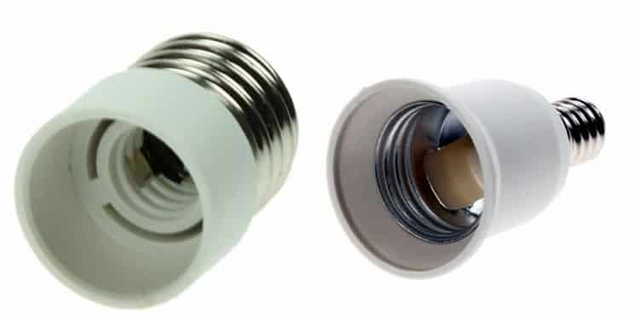
- Next, you need to determine the temperature of white light, the preferences for a particular room are indicated in the section on types of energy-saving sources.
- Having decided on the temperature, we choose the necessary power. It is difficult to give a recommendation, it all depends on the area of the room and the features of its interior. Comparative power for LN, most manufacturers are indicated on the box, but should not be particularly trusted. As practice shows, we can safely reduce this figure by 10-20%.
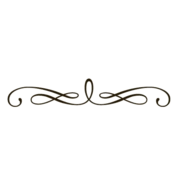
References for Text:
- http://www.sozialize.me/41406/fluorescent-light-specifications/impressive-fluorescent-light-specifications-88-fluorescent-light-fittings-dimensions-aperture-fluorescent-lamp/
- https://www.wired.com/2015/06/tested-bright-leds-compared-lights/
- http://www.livemint.com/Leisure/XcZQ3xIE3w6EhSijohHhuM/Forget-watts-think-lumens.html
- https://www.superbrightleds.com/blog/led-vs-incandescent-vs-halogen/707/
References for Images:
- http://housecraft.ca/eco-friendly-lighting-colour-rendering-index-and-colour-temperature/
- https://idavidmcallen.wordpress.com/2014/05/05/led-watt-conversion-light-replacement-guide/
- http://www.l-ateliergourmand.com/lumens-lighting-chart_led-lumen-chart-wattage-comparison-of-light-bulbs-craluxlighting_18.html
- http://housecraft.ca/eco-friendly-lighting-colour-rendering-index-and-colour-temperature/
- https://innoled.eu/lighting/2017/01/11/how-led-lighting-is-different/
Support @steemstem and the #steemstem
project - curating and supporting quality STEM
related content on Steemit
